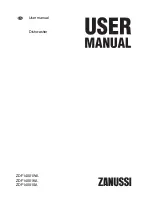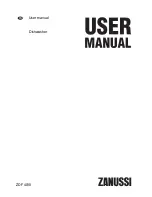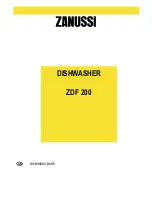
- 4 -
Care and cleaning
1
2
3
4
5
6
Important
Make sure that the machine is unplugged and the water
turned off before undertaking any kind of maintenance.
General cleaning
Inspect the filters and spray arm nozzle before re-loading
the machine and remove any food scraps. Wipe round
the rubber gasket at the bottom of the door to remove
grease which tends to collect there.
Rinse aid dispenser (1)
Use of rinse aid will result in faster drying of the load and
gives the dishes a shiny finish. It may be necessary to
adjust the quantity of rinse aid dispensed if you live in either
a very hard water or a very soft water area. More is needed
for hard water and less for soft water. Leave the dispenser
in its preset position when you first use the dishwasher and
only adjust if, after a few cycles, you notice the following:
• Crockery remaining dull looking and/or showing
occasional round spots. If this happens, increase the
quantity of rinse aid by turning the red dial below the
filler trough clockwise.
• Crockery feeling sticky or showing whitish spots. If this
happens, decrease the quantity of rinse aid by turning
the red dial below the filler trough anti-clockwise.
The dispenser holds about 140 ml. This is enough for 40-
70 wash cycles, depending on the dosage setting. When
the rinse aid level is approaching the bottom of the scale it is
time to refill the dispenser. Swivel out the filler trough and
carefully fill up with rinse aid until the level reaches up to
the red mark on the level indicator tube. Do not overfill, and
carefully wipe off any spillage with a damp cloth immediately.
Don’t forget to close the filler trough afterwards.
Do not fill the rinse aid dispenser with liquid
detergent.
Spray arm (2)
The holes in the spray arm nozzle must be kept clean to
ensure satisfactory wash results. Inspect the spray arm
regularly. When thorough cleaning is necessary, remove
the spray arm by unscrewing the nut clockwise (it has a
left-handed thread) and lift off the spray arm.
Wash the spray arm with hot soapy water using a stiff
saucepan brush if necessary to remove scraps.
Re-assemble carefully, making sure the nut is secure.
Coarse filter (3)
The purpose of the coarse filter is to catch large objects
such as toothpicks and pieces of eggshell. Make sure
that the filter is always clean. Lift it out and rinse it under
running water whenever necessary.
Fine filter (4)
It is just as important to keep this filter clean. A dirty or
clogged filter will impair washing efficiency. The fine filter
can easily be lifted out for cleaning when you have
removed the coarse filter.
The dishwasher must not be used without the
filters. Incorrect repositioning of the filters will
produce poor washing results.
Cleaning of the filters is vital to ensure correct
operation of the machine.


































